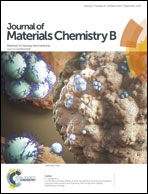Biofunctionalized pectin hydrogels as 3D cellular microenvironments†
Abstract
In situ-forming hydrogels of pectin, a polysaccharide present in the cell wall of higher plants, were prepared using an internal ionotropic gelation strategy based on calcium carbonate/D-glucono-δ-lactone, and explored for the first time as cell delivery vehicles. Since no ultrapure pectins are commercially available yet, a simple and efficient purification method was established, effectively reducing the levels of proteins, polyphenols and endotoxins of the raw pectin. The purified pectin was then functionalized by carbodiimide chemistry with a cell-adhesive peptide (RGD). Its gelation was analyzed by rheometry and optimized. Human mesenchymal stem cells embedded within unmodified and RGD-pectin hydrogels of different viscoelasticities (1.5 and 2.5 wt%) remained viable and metabolically active for up to 14 days. On unmodified pectin hydrogels, cells remained isolated and round-shaped. In contrast, within RGD-pectin hydrogels they elongated, spread, established cell-to-cell contacts, produced extracellular matrix, and migrated outwards the hydrogels. After 7 days of subcutaneous implantation in mice, acellular pectin hydrogels were considerably degraded, particularly the 1.5 wt% hydrogels. Altogether, these findings show the great potential of pectin-based hydrogels, which combine an interesting set of easily tunable properties, including the in vivo degradation profile, for tissue engineering and regenerative medicine.


 Please wait while we load your content...
Please wait while we load your content...